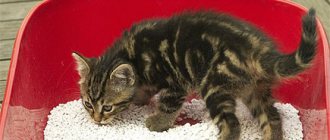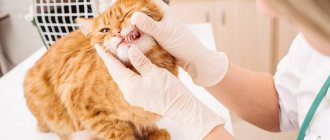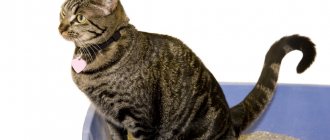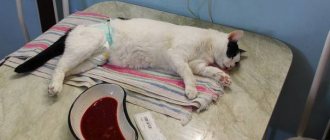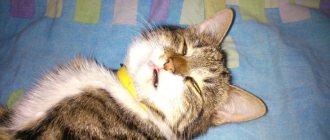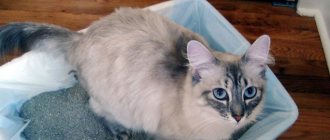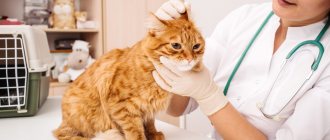Bloody stool is one of the most common problems faced by cats of any age and breed. Under no circumstances should it be left unattended. It is important to contact a veterinarian to find out what is the cause of bloody stools, how to help your pet, and whether possible problems can be prevented in the future.
Read in this article:
- Causes of blood in stool
- Additional symptoms
- What is important to pay attention to?
- Your actions
- Diagnostics
- Blood in a cat's stool: treatment
- Prevention
Causes of blood in stool
The first thing you need to pay attention to is the appearance of the blood. If it is fresh, this indicates that the bleeding began near the anus (for example, the anal sphincter is injured) or in the large intestine.
We draw your attention to the most common reasons why your cat goes to the toilet with blood:
- Eating disorder
- Parasites
- Gastrointestinal diseases
- Foreign bodies
- Neoplasms
- Dysbacteriosis
- Bleeding disorders
- Poisoning with toxic substances
If your pet's diet consists of low-quality dry food, its particles can injure the mucous membranes of the stomach. The likelihood of injury increases if the cat drinks little water. Dry food does not soak, and its sharp ends injure the stomach.
Worms, Giardia, coccidia and other helminths (protozoa) increase capillary permeability and injure the mucous membranes of the stomach. As a result, blood is mixed with the stool, but its volume depends on the number of parasites in the body.
Acute pancreatitis, liver dystrophy, chronic colitis and enteritis are just some of the diseases of the gastrointestinal tract that can cause the appearance of blood clots in the stool. If with an ulcer blood impurities are very noticeable, then with other diseases they are practically invisible.
Most often they enter the gastrointestinal tract during eating or drinking. Foreign objects (for example, pieces of plastic, bones) damage the integrity of soft tissues or cause constipation, in which solid feces slowly pass through the intestines, causing injury.
Passing through the intestine with malignant or benign neoplasms, feces encounter growths. The result is damage to the mucous membranes and the formation of blood impurities in the cat’s stool.
Intestinal bloating, heaviness and grumbling, as well as blood impurities in the stool - these signs are characteristic of dysbiosis that occurs when consuming low-quality or expired products (for example, spoiled milk or sour cream).
If your cat has problems with blood clotting (for example, a deficiency of vitamin K or prothrombin in the body), then even a minor injury can lead to severe bleeding.
Krysid, zoocoumarin and other poisons intended for rodents act on the principle of coagulants. By eating them, the cat's blood clotting is impaired, so a lot of blood appears in the feces. The only way to save your pet is to immediately contact a veterinarian.
What to do if your cat has blood in his stool?
If you notice even the smallest bloody droplets in your cat’s feces, you should immediately exclude dry food from his diet. This food is harmful to cats, and if they are fed it constantly, there is a high risk of developing gastrointestinal diseases or urolithiasis. You will also need to exclude dairy products from your cat's diet.
The cat needs balanced, dietary food. No canned food - only home-cooked food. Boiled chicken legs, breasts and thighs are suitable. You can try feeding your cat boiled rice put through a blender; the rice will strengthen the intestines well.
During the period of exacerbation of the disease, the cat will benefit from food rich in fiber, food that consists of complete fats and proteins. By radically changing the diet, you can save your furry pet from the problems that were caused by his individual food intolerance.
But if, after completely changing the diet, the cat still has blood and mucus, then you need to immediately take him to the veterinarian. Based on this or that diagnosis, he will prescribe medications and optimal dosages, and the cat’s owner should approach the treatment process very responsibly.
All these requirements must be met by the cat owner after noticing blood in the cat’s stool. But if it turns out that everything is much more serious, then diagnostics will be needed to identify the causes of the disease and treatment with therapy.
Additional symptoms
Blood in a cat's stool is often not the only symptom. If the cause of bloody stool is an infectious disease or the appearance of neoplasms in the gastrointestinal tract, then your pet will have other accompanying signs.
Among them:
- sudden weight loss,
- vomit,
- diarrhea,
- strong thirst
- sluggish and apathetic state,
- frequent urination (pay attention to the urine: it may also contain small amounts of blood),
- pain in the abdominal area.
Are you observing one or more signs in your pet? Don't hesitate - seek help from a professional veterinarian. He will give the cat an accurate diagnosis and prescribe effective treatment for the disease.
Preventing blood from appearing in a cat's stool
To ensure that the cat does not experience unpleasant sensations during bowel movements, and the current situation does not result in serious complications, the owner will have to follow simple rules and carry out the following preventive measures:
- Feed your pet correctly, namely choose a balanced diet, prevent the cat from overeating, and do not overuse dry food;
- Systematically carry out deworming;
- Keep your cat away from rodents and other pests;
- Make sure your pet always has access to fresh water;
- Take him to the veterinary clinic periodically.
If blood clots (extravasate) are found in a cat's stool, they should be taken to a veterinary clinic for examination.
No one knows his beloved furry pet as well as a cat owner, and only the owner can notice the slightest changes in his behavior. The appearance of blood in a cat's stool indicates a disorder in the cat's body. Finding out the cause of the disorder and saving the cat thanks to a correctly prescribed course of treatment should be entrusted to a veterinarian, and in no case should you self-medicate. In response to this, the recovered pet will certainly give its owner his affection and love.
What is important to pay attention to?
If your cat is walking around with a lot of blood, then carefully monitor your pet's condition. Pay attention to how often blood is present in his stool: once or regularly (for example, every time he visits the litter box).
It is important to consider whether your pet's behavior changes when visiting the litter box (for example, he meows or moans loudly, his tension and anxiety are noticeable). See how much blood is released: droplets, small clots or large amounts of impurities.
Other points that are important to pay attention to:
- change in appetite
- the presence of impurities in the stool (mucus, hairballs),
- increase in body temperature,
- general condition of the pet.
Note! All this is necessary to answer all the veterinarian’s questions if necessary. Taking into account your information, he will make a diagnosis and determine effective treatment.
Alarming symptoms
A person may notice a couple of drops of blood at the end of a pet's bowel movement.
This symptom is a reason to visit the veterinarian. If spotting appears more and more often, you should not delay treatment. Domestic cats often experience the following types of illnesses:
- diarrhea;
- strange impurities, liquid feces;
- lethargy, apathetic mood;
- refusal of any food;
- vomit;
- increased thirst;
- constipation, the cat strains a lot during defecation, meows;
- frequent urination;
- the appearance of blood regardless of visiting the toilet;
- high body temperature.
Even if one of the symptoms appears, you need to show the animal to a doctor. Many dangerous illnesses show themselves in this way. All diseases require effective therapy.
Your actions
What to do if your cat has bloody stool? If the blood impurities are small and this condition is not accompanied by other signs (high fever, vomiting), then wait until your pet’s next visit to the litter box.
Contact your veterinarian immediately if:
- Your cat is clearly having difficulty defecating (strains significantly, meows or moans loudly);
- Visits the toilet to defecate too often and her appetite (thirst) has decreased significantly;
- There are bright red blood in the stool more than once, and their size is larger than a speck.
Do not attempt to cure your cat at home - only a qualified veterinarian can make an accurate diagnosis.
Treatment of diarrhea
To eliminate loose stools with blood, depending on the causes of the disorder, antibacterial drugs, symptomatic drugs and anthelmintics can be used.
Symptomatic therapy and diet
For diarrhea mixed with blood, the pet is first prescribed a starvation diet. It is necessary for intestinal restoration. In the absence of irritants, his condition will improve, which will allow him to begin basic therapy. Adult animals are not fed for 24 hours, kittens - up to 12 hours, depending on age. With diarrhea, most of the nutrients are not absorbed by the body due to the excessive secretion of mucus, so the diet will not harm the pet’s body.
To partially relieve inflammation and protect the gastrointestinal tract from the effects of acids during fasting, Phosphalugel can be used. In case of intoxication, absorbents may be prescribed. Smecta is often used to eliminate diarrhea, but it may not be effective enough.
If your pet is showing signs of dehydration, hydration medications may be prescribed. In critical cases, saline, glucose, and Ringer's solution are administered intravenously to prevent dehydration.
After a starvation diet, the pet is transferred to fractional meals. The animal is given 1/4 of a standard portion at a time, but is fed more often. The diet includes white poultry meat, boiled rice, and low-fat broth. If you need to provide your pet with calories, give baby food without additives. With a normal physique, its use is inappropriate.
Anthelmintics
If the question arises about how to treat bloody diarrhea, it is necessary to clarify the cause of the disease. If worms or their eggs are found in the stool, anthelmintic drugs are prescribed. It is advisable to give them after the condition has normalized and the blood has disappeared, since the drugs are a toxin. The drugs may increase symptoms due to their negative effects on the intestinal wall.
Antibacterial drugs
Antibiotics are prescribed in most cases, because when ulcerations appear on the mucous membranes, there is a risk of infection. First, broad-spectrum drugs are used. When bacteria are detected in feces, a remedy is selected that is most effective against the identified strain. The drugs can be given at home, but it is recommended that treatment be carried out under the supervision of a veterinarian, since he will be able to competently assess the pet’s condition and select an analogue in time if adverse reactions occur.
Diagnostics
The key to successful treatment is a thorough diagnosis. The veterinarian conducts a clinical examination, collects anamnesis, and asks questions to the pet owner. If necessary, additional diagnostic methods are prescribed:
- blood analysis,
- stool examination to determine the presence of helminths or protozoa,
- Analysis of urine,
- colonoscopy.
Additionally, an ultrasound or x-ray examination of the abdominal cavity is prescribed to exclude or confirm the possibility of damage to internal organs.
Causes of pathology
When cleaning up the pet's potty, the owner may discover that there are several drops of blood on the feces, or that the entire mass of feces is colored reddish. Let us note right away that this is not normal, and such a signal indicates that the animal needs increased observation and attention from humans.
If blood was detected in the stool of a furry pet once, the symptom did not recur again, and the general condition of the animal is assessed as good (that is, the pet is cheerful, cheerful, eats, actively responds to affection), there is no need to worry. Most likely, there was a one-time injury to the animal’s rectum (for example, the mucous membrane could have been scratched by a sharp piece of undigested food or a small foreign object that came out naturally).
If blood appears in the stool again and again, you need to find out the reason for its appearance immediately. In a situation where bloody spots in the animal’s feces are accompanied by such manifestations as lethargy or lethargy of the pet, diarrhea or constipation, refusal to eat, increased or decreased body temperature (the norm for an adult cat is within 38-39 degrees), you need to take the pet to the clinic immediately.
The determining factors due to which a cat goes “out of need” with blood for some time are mainly the following:
- intussusception;
- gastroenteritis;
- stomach ulcer;
- helminthic infestation;
- dysbiosis accompanied by constipation;
- vascular diseases;
- bacterial infection;
- injury to the anus or intestines;
- allergic reactions;
- blood clotting failure;
- foreign objects;
- severe intoxication (when chemicals enter the body);
- benign and malignant tumors.
Blood in your cat's stool is most often caused by irritation in the lower intestine. In addition to the symptoms of hematochezia, allergies and food intolerance can be caused in pets by ordinary food, most often dry food from a dubious manufacturer.
If your cat spends most of its life in the yard or on the street, then it may have been poisoned by rat poison, then bloody stools are a common occurrence. Also, if you notice very hard and extremely dry stools in your cat, then these are clear signs that the animal has nutritional problems.
Among other things, parasites, E. coli, bacteria, worms and other agents carrying viruses of various etiologies can also cause diseases accompanied by bloody feces. Therefore, always, as a caring owner, make sure that your beloved cat does not eat just anything, anywhere, but eats normally and drinks plenty of fluids.
Blood in a cat's stool: treatment
Having found out why the cat has bloody stool, the specialist draws up a treatment plan. If there are foreign objects in the esophagus or neoplasms are detected, regardless of their nature, only surgery under general anesthesia will help.
If the cause of bloody stools is poisoning, then an antidote with a high content of vitamin K is administered. Additionally, droppers and gastric lavage are prescribed. Maintenance therapy and iron supplements are selected.
For infections, symptomatic treatment is prescribed, and it is important to start it in the first 72 hours to prevent the possibility of complications. The specialist will leave the pet under observation and select medications.
Foreign body as a cause of blood during bowel movements
In addition, when trying to find out why the animal suffers when going to the toilet in a big way, it may turn out that there is some kind of foreign body in the cat’s intestines or esophagus. At the same time, it is important to determine the nature of the bloody discharge and the stool itself. If your pet went to the toilet only after a lot of meowing and noticeable discomfort, it is likely that the presence of a foreign object is the very root of the problem.
Often, cats, playing with objects whose purpose is probably not related to cat leisure, can cause significant harm to their body. Meanwhile, it happens that the owners themselves do not look after the animal enough, which simply walks on its own, or provide them with dangerous things to play with, without thinking that this should not be done. Sharp objects or pieces of fabric that have gotten inside the body of a cat or kitten can affect the emptying process. If your pet goes to the toilet with blood, most likely foreign objects have caused significant damage to the gastrointestinal tract. Also, do not forget about the toxicity of many plastic toys, synthetic materials, bottles, etc. Once in the cavities of the digestive organs, such objects can become the main source of irritation of the walls of the intestines and stomach.
In cases where going to the toilet is a real torment for a cat, there are often other common reasons listed in the list above. For example, infection with protozoan parasites - worms - is a fairly common situation.
Prevention
To prevent the formation of blood in your cat’s feces, it is enough to follow simple rules: provide the correct diet, keep chemicals, poisons and rodent poisons away, and also maintain your pet’s personal hygiene.
First, don’t feed the cat:
- any food from the “human” table,
- pork,
- tomatoes and eggplants,
- foods with a lot of seasonings,
- cereals.
Everything fatty, salty and fried will only harm your pet. Your cat's momentary joy can lead to serious and undesirable consequences in the future, including the appearance of blood in her stool.
Secondly, ensure the hygiene of the animal. It is recommended to accustom your cat to washing its paws and brushing its teeth from an early age. Teeth brushing should be done at least 2 times a week, and paws should be washed after each visit to the street.
So, blood in a cat's stool is a deviation from the norm. It is impossible to independently determine the cause of this condition, so you should not hesitate to contact a professional veterinarian in Moscow. Remember that in many cases your pet’s future health depends on your reaction!
How is the treatment carried out?
Effective medications
Treatment is prescribed depending on the type of parasite, for example, a frequently used drug is Pyrantel.
If blood impurities during a cat's toilet visit are caused by helminthic infestation, it will be necessary to identify the type of parasites. Then the doctor prescribes a course of treatment, which is based on eliminating the specific pathogen. Often prescribed:
- "Kaniquantel";
- "Dirofen";
- "Febtal";
- "Pyrantel".
If the problem is caused by intoxication of the body with poisons, a specific antidote is administered to the cat. When no more than 3 minutes have passed after consuming this substance, the owner can provide first aid to the animal, which consists of inducing vomiting. For these purposes, it is recommended to add 50 ml of peroxide to 100 milliliters of water. The solution is given depending on the cat’s body weight. For 1 kg of weight there are 2 tsp. solution. After vomiting has been induced, use activated charcoal or Enterosgel.
After 3 hours, you should give the cat a laxative. It is permissible to use castor oil.
If colitis is observed, resort to the antibacterial drugs Tylosin and Metronidazole. Anti-inflammatory pharmaceuticals are also used, for example, Sulfasalazine. It cannot be done without maintenance therapy. For these purposes, vitamin and mineral complexes for animals are prescribed.
Traditional treatment
In combination with classical treatment, it is recommended to give your pet mint infusion, which is taken before meals.
In combination with medications, it is permissible to resort to the help of healers’ recipes. One of the most useful is mint infusion. To prepare it, you will need to take 1 tablespoon of the plant, add 500 ml of hot water and leave for half an hour. The infusion is given to the cat once a day before eating. Dried fruits, for example, prunes and dried apricots, will also help improve digestion.
The right approach to nutrition
Veterinarians from the Zoovet clinic recommend that owners of animals who have blood after going to the toilet switch their cats to natural food. Your pet should be given boiled lean meat, buckwheat, eggs and vegetables. It is important to exclude fermented milk products from the menu. It is permissible to return to industrial complementary foods after the cat’s condition has completely normalized and a course of therapy has been completed.
Treatment
Having discovered discharge in the feces of a furry friend, caring owners must seek medical help from a veterinarian. Based on the owner’s complaints and external manifestations, the doctor will make a diagnosis, prescribe medications and explain the rules for caring for a sick pet. In especially severe cases, the sick individual is left in the clinic.
The sooner a specialist examines the animal and prescribes treatment, the more favorable the outcome of the disease will be for your pet!
Diagnosis of the problem
The key to quickly getting rid of the problem is correct and timely diagnosis. It is very difficult for a non-specialist to make a diagnosis. That is why, if drops or blood clots are detected in your pet’s stool, you must contact the nearest veterinary clinic.
You should not hesitate if, in addition to the main complaint, your pet has:
- thirst or, conversely, lack of desire to drink water;
- lumps of unknown composition in the vomit;
- the appearance of pieces of undigested food in the stool;
- stench and change in color of stool;
- temperature, expressed by dry mucous membranes and nose;
- dullness of the eyes;
- hard breath;
- heartbeat;
- convulsions;
- a sharp decrease in body weight.
Lack of appetite when impurities are detected in the feces or strong cries of the animal when trying to relieve itself are also considered indications for visiting a doctor. In the clinic, you should be prepared for the fact that the pet will have to undergo a number of tests, such as stool and urine analysis. In addition, the doctor will definitely examine the animal and palpate the organs.
In special cases, when the veterinarian suspects a blockage in the stomach or intestines, an ultrasound examination of the abdominal cavity or x-ray is performed.
Survey
Progress of treatment
The course of treatment for such a pathological manifestation as extravasation in feces will depend on the type of disease and the degree of its neglect.
- If inflammatory processes caused by bacteria are detected, the patient is prescribed antibiotics. They come in the form of tablets or injections.
- If the disease is caused by a blockage or rectal prolapse occurs, then surgical intervention is often required.
- Helminthic infestations are treated with special drugs to combat parasites, and dysbiosis is treated by introducing enzymes into the diet to speed up digestion or biological products: pro- and prebiotics.
- If the patient is weakened or the intoxication of his body is high, then cleansing droppers or infusions (injections) are prescribed.
In any case, if impurities and blood are detected in the feces, the sick animal is prescribed a gentle regime and diet for the period of illness. Food should be very soft and rich in minerals and vitamins.
Veterinarian examination
Signs of bleeding in cat stool: hematochezia and melena
Cat feces normally have a uniform structure and fairly dense consistency, cylindrical shape and brown color. They are characterized by a specific mild odor. Milk-fed kittens have lighter-colored excrement and a softer consistency than adult cats.
The phenomenon in which unchanged blood or traces of it are found in the stool is called hematochezia. Hematochezia is a symptom of a disease that causes bleeding into the lumen of the cat's digestive system. Typically, hematochezia indicates lesions in the sections following the stomach and duodenum.
Hematochezia is a pathology of the lower intestine of a cat, characterized by the presence of bloody traces in the feces
When the source of bleeding is located in the stomach or duodenum, the color of the stool becomes black and tarry. This phenomenon is called melena. The black color of blood is obtained from the action of the digestive enzymes of these organs on it. The consistency of stool during melena is usually liquid or semi-liquid, and a sharp unpleasant odor is also characteristic.
Melena is a black, semi-liquid stool with a characteristic unpleasant odor, formed from the blood under the influence of the contents of the stomach and intestines.


